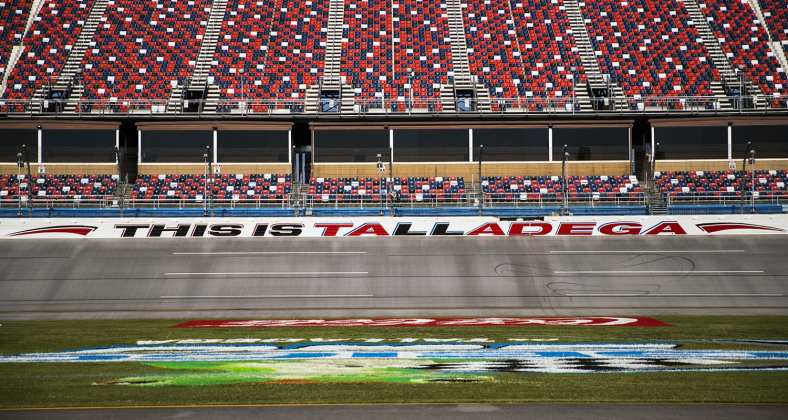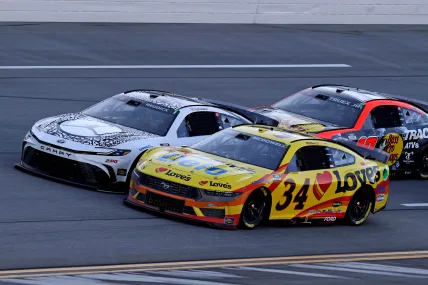
When it comes to the fuel saving debate generated from the Cup Series race at Talladega Superspeedway on Sunday, the league’s senior vice president of competition, Elton Sawyer has two minds about it.
There is a personal opinion and a professional opinion representing NASCAR and he shared both on Wednesday morning during his weekly appearance on SiriusXM NASCAR Radio.
First, Sawyer said superspeedway racing has continually evolved over the past 50 years from unrestricted engines to single-file racing with restrictor plates to pack and tandem racing with fuel conservations being the next step.
“The good part of that, I believe, not speaking as a sanctioning body but as a fan of the sport, having the drivers managing that, and the strategy on top of the pit box, when to pit and when to go, this is a point and time in our superspeedway racing,” he said.
But by in large, most fans rejected a race where drivers spent most of the race on 50-60 percent throttle and nearly made it the entirety of the first and second stages without even having to pit. The historical absurdity was not lost on JTG Daugherty crew chief and competition director Mike Kelley after the race.
“30 years of doing this and never thought we would come to the fastest track on the planet and run five seconds off the pace but these are the cards we have been dealt right now,” Kelley said.
The idea is that saving fuel on the track would result in less time on pit road, and thus, being able to gain track position that way in a scenario where it would be hard to pass once everyone was back on the throttle and racing it out.
“As long as the rules are the same way, we still have to race for points and race for the best finish possible,” Kelley added. “All week, we’ve spent our race prep trying to determine how aggressively we could fuel save and we nearly reached a dangerous point where we almost could have made an entire stage without pitting.
“I don’t know if that’s good or bad but it’s different.”
Once drivers started racing for the stage and race wins, it became incredibly hard to pass, so those are the factors Sawyer said NASCAR needs to consider when pondering any potential rule changes for future superspeedway races.
Again, he has two feelings towards that.
“With all that being said, we are looking at it, and if we feel like there needs to be a change, and I don’t know that there is a fix, we can look at things in collaboration with our TV partners and our teams to make a change if we all feel like we need to,” Sawyer said.
But again, Sawyer urged, that any changes would result in a new unintended consequence and that the history of the sport is full of those examples.
“If you look at it over time, there will be something new that will come down the road in superspeedway racing,” he said. “I think that’s all-in-all the great part of our sport, the unknowns that come with it.
“Again, a lot of words there but I would say we would never be closed-minded with our thoughts and industry on how we could make our sport better.”
The most common change suggested by the garage, if a change has to be made, is that a fourth stages would eliminate the need to save fuel. It would also eliminate green flag pit stops — a key competitive variable.
Is that on the table?
“I don’t think there’s anything that’s off the table,” Sawyer said. “We look at it as do we want to take fuel mileage completely out of the event? And sure, we could do that, with where we put stage breaks.
“But does that add to the entertainment value of superspeedways? Does that take away from it? I’m sure there are fans that for the most part enjoyed what they saw on Sunday and there are those who have a different view.
“That’s what fans enjoy about our sport, and our passionate fans about what they do and don’t want to see and it’s our job to put all of that together and put the best product out there.”
The extra stage idea was floated out there by Stewart-Haas Racing No. 4 crew chief Rodney Childers.
“We already do that for the Coca-Cola 600 and that works,” he said. “But that will make it to where the (fuel) runs are already played out. I know that’s not what us crew chiefs want, because we like having options, but on the other hand, if the stages were 40 laps instead of 60, there wouldn’t be any fuel saving.
“We’d be hauling butt the whole race.”
But that would eliminate strategy from the race and with a car that struggles to pass in the draft, fans might push for that to changes again too.
So it’s just complicated.
Matt Weaver is a Motorsports Insider for Sportsnaut. Follow him on Twitter.


